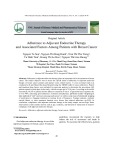
Dynamin-like protein-dependent formation of Woronin
bodies in Saccharomyces cerevisiae upon heterologous
expression of a single protein
Christian Wu
¨rtz, Wolfgang Schliebs, Ralf Erdmann and Hanspeter Rottensteiner
Institut fu
¨r Physiologische Chemie, Ruhr-Universita
¨t Bochum, Germany
The HEX1 protein of Neurospora crassa, identified by
Jedd and Chua [1] and Tenney et al. [2], is the major
component of a class of microbodies limited to euasco-
mycetes and some deuteromycetes, the so-called Woro-
nin body [3,4]. Because of the syncytial growth of
filamentous fungi, wounding of hyphae can lead to a
severe loss of cytoplasm and subcellular organelles, if
the plasma membrane or a nearby septum is not rap-
idly sealed. For this reason, the Woronin body is pres-
ent in filamentous euascomycetes and plugs septal
pores immediately after cells have been damaged [1,2].
In addition to septal pore sealing in cases of injury,
Woronin bodies have also been described as being
required for efficient pathogenesis, survival during
nitrogen starvation [5] and conidiation [6] in various
fungi.
Although it is more than 140 years since the dis-
covery of this very specialized organelle [4], our knowl-
edge of the biogenesis of Woronin bodies remains
incomplete. Electron microscopy studies provided the
first evidence that Woronin bodies are derived from
other microbodies [7]. These findings have been
extended by reports showing that Woronin body
formation is initiated in the vicinity of glyoxysomes
and may proceed through fission from them [8], and
by the demonstration that PEX14 is a key player in
the biogenesis of both glyoxysomes and Woronin
bodies [9]. Furthermore, the presence of a C-terminal
canonical peroxisomal targeting signal type 1 (PTS1) is
required for the proper topogenesis of HEX1 [9] and
allows HEX1 to be imported into peroxisomes upon
heterologous expression in yeast [1]. Peroxisomal
Keywords
filamentous fungi; Neurospora crassa;
peroxisome; protein import; yeast
Correspondence
H. Rottensteiner, Institut fu
¨r Physiologische
Chemie, Abt. Systembiochemie, Ruhr-
Universita
¨t Bochum, D-44780 Bochum,
Germany
Fax: +49 234 321 4266
Tel: +49 234 322 7046
E-mail: hanspeter.rottensteiner@rub.de
(Received 22 January 2008, revised 27
March 2008, accepted 2 April 2008)
doi:10.1111/j.1742-4658.2008.06430.x
Filamentous ascomycetes harbor Woronin bodies and glyoxysomes, two
types of microbodies, within one cell at the same time. The dominant pro-
tein of the Neurospora crassa Woronin body, HEX1, forms a hexagonal
core crystal via oligomerization and evidence has accumulated that Woro-
nin bodies bud off from glyoxysomes. We analyzed whether HEX1 is suffi-
cient to induce Woronin body formation upon heterologous expression in
Saccharomyces cerevisiae, an organism devoid of this specialized organelle.
In wild-type strain BY4742, initial import of HEX1 into existing peroxi-
somes enabled the formation of organelles with a hexagonal crystal. The
observed structures mimicked the shape of genuine Woronin bodies, but
exhibited a lower density and were significantly larger. Double-immuno-
fluorescence analysis revealed that hexagonal HEX1 structures only occa-
sionally co-localized with peroxisomal marker proteins, indicating that the
Woronin-body-like structures are well separated from peroxisomes. In cells
lacking Vps1p and Dnm1p, dynamin-like proteins required for the division
of peroxisomes, the Woronin-body-like organelles remained attached to
peroxisomes. The data indicate that Woronin bodies emerge after the
formation of a HEX1 core crystal within peroxisomes followed by Vps1p-
and Dnm1p-mediated fission.
Abbreviations
PMP, peroxisomal membrane protein; PNS, post-nuclear supernatant; PTS1, peroxisomal targeting signal type 1.
2932 FEBS Journal 275 (2008) 2932–2941 ª2008 The Authors Journal compilation ª2008 FEBS








































